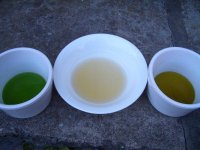I found this method for making Red Oil. Anyone ever heard of this? Does this make sense to anyone? I have the NaOH and HCl in my work lab. I don't have the petroleum ether. Any suggestions?
- dry, grind and soak material in 91% (or higher) isopropyl alcohol for three days.
- strain and filter, saving alcohol/oil mixture.
- evaporate off alcohol down to ~ 250 - 300 ml of alcohol/oil mixture.
- extract alcohol/oil mixture w/ petroleum ether three times.
* extract = placing two solutions in a separatory funnel, mixing thoroughly, and allowing the two phases to separate...
--- given petroleum ether & alcohol >> (petroleum ether on top) (alcohol on bottom)
--- given petroleum ether & NaOH soln >> (petroleum ether on top) (NaOH soln on bottom). same for petroleum ether and acidified NaOH solution.
* to make the NaOH solution - mix 40 mg of pure NaOH pellets into 500 ml of distilled water until dissolved thoroughly. then add 500 ml of absolute grain alcohol (everclear), yielding ~ 1 liter of the sodium hydroxide solution.
* white gas can be substituted for pet ether (verified) muriatic acid (swimming pools) can be substituted for HCl (verified) lye can be substituted for NaOH (verified).
- dry, grind and soak material in 91% (or higher) isopropyl alcohol for three days.
- strain and filter, saving alcohol/oil mixture.
- evaporate off alcohol down to ~ 250 - 300 ml of alcohol/oil mixture.
- extract alcohol/oil mixture w/ petroleum ether three times.
* extract = placing two solutions in a separatory funnel, mixing thoroughly, and allowing the two phases to separate...
--- given petroleum ether & alcohol >> (petroleum ether on top) (alcohol on bottom)
--- given petroleum ether & NaOH soln >> (petroleum ether on top) (NaOH soln on bottom). same for petroleum ether and acidified NaOH solution.
* to make the NaOH solution - mix 40 mg of pure NaOH pellets into 500 ml of distilled water until dissolved thoroughly. then add 500 ml of absolute grain alcohol (everclear), yielding ~ 1 liter of the sodium hydroxide solution.
* white gas can be substituted for pet ether (verified) muriatic acid (swimming pools) can be substituted for HCl (verified) lye can be substituted for NaOH (verified).



